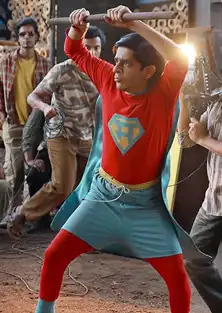Quick take: Superboys of Malegaon is a heartwarming tale about a group of friends who dared to make films their own way.
Critic’s rating (4.0 / 5)
Superboys of Malegaon is a jubilant celebration of the human spirit, a love letter to the art of storytelling, and an ode to the transformative power of friendship. Directed by Reema Kagti and penned by Varun Grover, this layered film is a heartfelt exploration of the magic of cinema and the unbreakable bonds that fuel its creation. Inspired by the acclaimed documentary Supermen of Malegaon (2012), directed by Faiza Ahmed Khan, the film pays homage to the real-life dreamers of Malegaon who defied the odds to create their own brand of cinema. It’s ironic, to say the least, that Superboys of Malegaon is a mainstream Hindi film based on a group of people who bucked the system to come up with their own brand of cinema. Life has come full circle for the Malegaon film industry, which thrived on making copies, even parodies, of popular films such as Sholay. What began as a grassroots movement to reclaim storytelling from the clutches of commercialism has now inspired a mainstream film that celebrates their spirit of rebellion and creativity.
At its heart, the film follows Nasir (played with an irresistible charm by Adarsh Gourav), a wedding videographer with an unshakable love for the golden age of cinema. His journey is one of passion, resilience, and audacity—from screening Charlie Chaplin and Buster Keaton movies in a crumbling theater to rallying his ragtag group of friends to create a shoestring-budget homage to iconic films like Sholay. Nasir’s efforts are defiant acts against a system that thrives on replication. They also offer a heartfelt tribute to the daring innovators who once defined the medium. Through his eyes, we are reminded of a time when cinema was about bold experimentation, not safe formulas. Varun Grover, through Vineet Kumar Singh’s character Farogh, shows how badly writers are treated in our industry. “Writer baap hota hai,” roars Farogh. He’s someone who stands for originality and makes a beeline for Bollywood when his friends mock him for bringing original ideas to the table. It’s another matter that he finds no takers for his originality in the Hindi industry. Then, there’s also Shafique (Shashank Arora), a glorified ‘extra’ on the sets of Nasir’s films who becomes the catalyst for bringing the friends together again after they part ways due to jealousy and misunderstanding.
See also: How Vineet Kumar Singh Improvised A Key Dialogue In Superboys Of Malegaon
Set against the backdrop of a changing India, from the late ’90s to the early 2010s, Superboys of Malegaon is a vibrant celebration of India’s jugaad culture. The film offers a poignant exploration of the tensions between artistic vision and compromise, and is also testament to the power of collaboration. What truly sets Superboys of Malegaon apart is its celebration of diversity and representation. In today’s strange times, where the Muslims are often made out to be villains, the film portrays its predominantly Muslim characters with dignity, warmth and authenticity. They aren’t crime lords or terrorists. Their biggest crime is that they are dreamers. Kudos to Grover and Kagti for not succumbing to the concurrent narrative.
But perhaps the film’s greatest triumph is its celebration of friendship. The chemistry among the core group of friends is palpable, their banter and camaraderie infusing every scene with joy and heart. Their collaborative misadventures, filled with laughter, setbacks, and small victories, become a moving tribute to the human spirit.
Superboys of Malegaon is more than a quirky comedy or a nostalgic homage to cinema—it’s a bold, hopeful statement about the cyclical nature of art. It reminds us that even in an industry built on copies and parodies, there is always room for originality, passion, and innovation. The ensemble cast, which look and feel as if they were actually from Malegaon, have given a credit worthy performance. Their timing is spot on and they play off each other to provide sincere portrayals. Director Reema Kagti has kept a realistic tone throughout. Though the conflict resolution between the friends is too sudden, it fits with the overall narrative. The production design and costumes are on point as well. Cinematography by Swapnil S. Sonawane captures the film within the film plot lines effectively, while editing by Anand Subaya keeps the pace flowing.
It’s a film that celebrates the beauty of imperfection, the power of community, and the enduring magic of cinema. For anyone who has ever been moved by the art of storytelling, this is a cinematic experience that will leave you inspired and uplifted. It’s a salute to all the unsung heroes who have kept their dreams alive even in the midst of adversity.
News Credits: Filmfare.com










